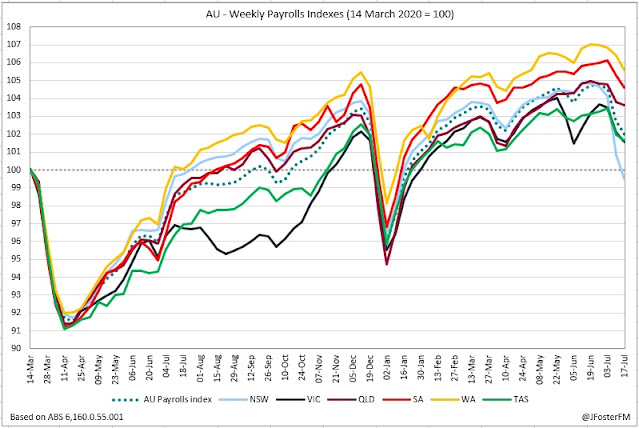Australia's labour force survey for July is due to be released by the ABS at 11:30am (AEST) this morning. Ahead of the recent outbreaks and associated lockdowns, labour market conditions were strong with employment rising well above pre-pandemic levels, participation around record highs and the unemployment rate at its lowest in more than 10 years. There is likely to be some loss of this momentum until the time when vaccination rates rise to levels that can support sustainable reopenings. While forward-looking indicators of labour demand have weakened lately, job vacancies remain at elevated levels, suggesting the outlook beyond the near-term headwinds is positive.
As it stands | Labour Force Survey
Employment posted a stronger-than-expected rise of 29.9k in June to consolidate the 115.2k surge from May (reviewed here). This advanced total employment up to 13.154 million to be 1.2% above its pre-COVID level.
The leadership continued to come from the full-time segment with employment rising by 51.6k in June, though this was moderated by a 22.5k fall in part-time employment. Weakness in the part-time segment was driven by New South Wales and Victoria, with the latter in a snap lockdown over the survey reference period. Through the June quarter, full-time employment increased by 182.6k to stand 1.7% higher than its pre-pandemic level. The part-time segment led in the initial phase of the recovery but employment has since leveled out to be around pre-pandemic levels.
With the participation rate unchanged in the month at 66.2%, the strength in employment drove the unemployment rate down further, falling from 5.1% to 4.9% — its lowest level in 10½ years. However, both underemployment (7.9% from 7.4%) and underutilisation (12.8% from 12.5%) increased in July reflecting the disruption from the Victorian lockdown.
Total hours worked contracted by 1.8% in June, slowing annual growth from 13.0% to 6.8%. The return to lockdown from late May led to hours worked in Victoria plunging by 8.4% in June, which was its steepest decline since the onset of the pandemic. Queensland also recorded a decline in hours worked in June (-1.1%) but all other states saw hours worked maintained or increased over the month.
Market expectations | Labour Force Survey
Throughout the July reference period, Sydney was in lockdown while stay-at-home mandates in place in Brisbane, Perth and Darwin were lifted early in the month. Victoria entered its 5th lockdown towards the end of the reference period after reopening around 4 weeks earlier. The impact on the labour market from these disruptions has been reflected by the weakening in the ABS's payrolls data (chart below). For today's release, the median estimate is for employment to fall by 43k in July. However, as has been the case over the pandemic period, the effects of lockdowns have been more pronounced on hours worked rather than employment, with fiscal support measures attenuating the impact on the latter. The national unemployment rate is forecast to tick up slightly from 4.9% to 5.0% (range: 4.5% to 5.2%). Lockdown disruptions are likely to weigh on the participation rate, in turn limiting the extent to which unemployment might rise.
What to watch | Labour Force Survey
While a weak report is expected today, the full impact of the Delta disruption on the Australian economy will come through in August when around 60% of the population was in lockdown early in the month. The change in hours worked for July is the figure to watch today and will be used to help guide assessments on the hit to GDP in Q3. The participation rate is another area of interest given how responsive it has been to strong employment outcomes through the recovery. There is now likely to be some unwinding in the participation rate given the lockdowns and the pace at which it snaps back when reopenings occur will be a key factor to the strength of the rebound.






